#rko short film
Explore tagged Tumblr posts
Text
The Jitters. Directed by Leslie Goodwins. Performance by Leon "Rubberlegs" Errol. Alpha Home Entertainment, 2021.

"Do you really mean to say that the comedian was only shamming and that he wasn't drunk at all? I don't believe it."
-"Acting Was Too Real"

Bert Williams, Ida Adams, Leon "Rubberlegs" Errol, 26 Oct 1912

Leon "Rubberlegs" Errol in A Rented Riot (1937)
----------------------------------------------------------------------------
Hitchy Koo girl Ray Dooley said about Errol♥

"What do you think of a man who, having given you roles that you're never hoped to attempt, works with you, coaching, rehearsing and encouraging, until you actually make good? Why, Mr. Errol is a miracle man! He loves to develope personalities, is always open to suggestions and will work for hours to get an effect. He's kind and helpful and interested in everyone;"
-"Leon Errol Is a Miracle Man, Says Little Ray Dooley", 1918
Roscoe Arbuckle said about Errol ♡

While doing a stint in a Portland, Oregon, theater in 1905, he agreed to join two burlesque comedians, Leon "Rubberlegs" Errol and Pete Gerald, during their run across the upper West. It was a gig that, despite halving his pay, allowed him to branch out from illustrated songs to sing numbers untethered to a slide show—and to try his hand at comedy.
He said it was Errol "who persuaded me that I had a voice, ability, and that I would make a good actor." Errol also "taught me several valuable things like how to fall all over the place without making myself a candidate for a hospital." Practicing stunts, dancing soft-shoe, mastering comedic timing, personifying characters in costumes and self-applied makeup—this was Arbuckle's education, Errol was his teacher, and stages were his schools. At eighteeen, he began to develop the skills of a comedian.
-Merritt, G., 2013, Room 1219, Chicago Review Press Incorporated, p.23
"아버클은 리옹 ��롤이 '내가 좋은 배우가 될 수 있는 능력을 갖고 있다는 걸 확신시킨 사람'이라고 말했다고 한다. 또한 '어떻게 하면 병원 예약 안 하고 여기저기서 넘어질 수 있는지 알려준 사람'이라고도 했다. 작가는 또한 리옹 에롤이 아버클의 스승(teacher)이었다고 쓰고 있다. 단순한 고용주(boss)를 넘어서 말이다."
-23/3/6
#leon errol#ray dooley#hitchy koo of 1918#roscoe arbuckle#ziegfeld follies of 1912#a rented riot 1937#the jitters 1938#favorite#기사 인용#책 인용#rko short film
2 notes
·
View notes
Text


"I suppose you think I've changed, too." "Not anymore than could be expected. I suppose every man when he grows old begins to lose prideness on personal appearance."
-Edgar Kennedy & Vivien Oakland in Beaux and Errors (1938)
#beaux and errors 1938#edgar kennedy#vivien oakland#rko short film#rko short comedy#rko comedy#favorite
0 notes
Text
Donald Haines in Flirting in the Park (1933)
0 notes
Photo
In Technicolor

Donald’s Gold Mine, 1942
26 notes
·
View notes
Text
Favorite films discovered in 2024
This year, I focused more on rewatching films I hadn't seen in a long time rather than racking up new titles. However, I still encountered plenty of new faves, many of them movies that have been on my watchlist for years. Here are the top twenty.
But first, some interesting patterns in this year's list...
Most represented decade: 1960s
Earliest film represented: 1932
Newest film represented: 1999
Creatives who show up more than once: Robert Mulligan, Walter Matthau, Boris Karloff
The Window (dir. Ted Tetzlaff, 1949)
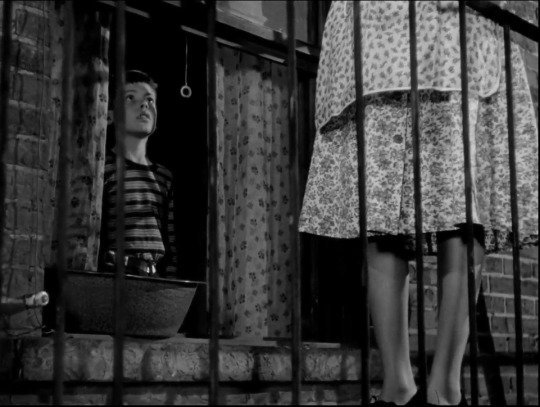
A young boy (Bobby Driscoll) living in a squalid NYC apartment building witnesses his neighbors (Paul Stewart and Ruth Roman) committing a murder. Unfortunately, the kid's penchant for tall tales prevent anyone from believing him-- except for the killers, eager to alleviate themselves of an inconvenient witness.
Precious few thrillers earn the moniker “Hitchcockian” as well as this intense little gem from RKO. The Hitchcock vibes make sense when you consider Hitchcock’s cinematographer from Notorious was in the director’s chair and the source material was written by Cornell Woolrich, also responsible for the short story behind Rear Window. Augmented by on-location photography of New York City and a grimy, desolate sense of urban decay, The Window is both a great suspense yarn and classic film noir. Despite having a kid for a lead character, the film pulls no punches: both its small-time crook villains and the city setting feel palpably dangerous.
My Neighbors the Yamadas (dir. Isao Takahata, 1999)
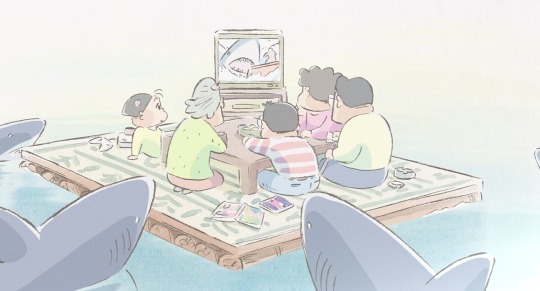
The Yamadas, an average middle-class Japanese family, navigate the perils of sharing a television set, a kid going missing during a shopping trip, awkward wedding speeches, and other misadventures.
Between the original Studio Ghibli directorial duo of Hayao Miyazaki and Isao Takahata, Miyazaki will always be the more popular filmmaker, but I think Takahata’s films are more intellectually and emotionally rewarding. This is not meant as a hit on Miyazaki’s undeniable greatness, but Takahata’s movies are far more challenging. That being said, My Neighbors the Yamadas is a lighter entry in his filmography, a slice of life comedy about the eponymous family and their shenanigans in modern Japan. However, beneath the whimsical humor runs an undercurrent of melancholy, an awareness of the transience of life in both its lovely and absurd moments. To date, it gets my vote for the most underrated Ghibli film.
A New Leaf (dir. Elaine May, 1971)
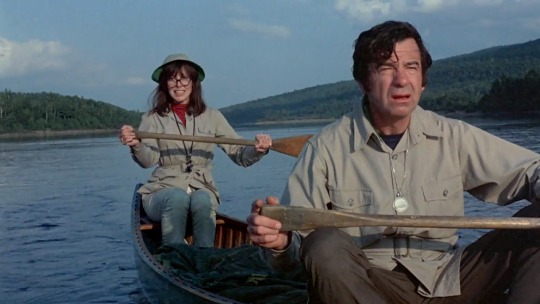
After squandering his ample inheritance, a middle-aged New York layabout (Walter Matthau) decides to marry an eccentric botanist (Elaine May) for her money then murder her ASAP.
Elaine May only directed a few films, but the two I’ve seen—this and the long-maligned Ishtar—were a lot of fun. A New Leaf is the better film though, far more focused and consistently funny. I don't usually belly laugh when watching a movie at home alone, but I did several times here. Even just thinking about some of the things that happen in this film can make me start laughing again. I understand the existing version was not May’s preferred cut and she felt it was butchered by the studio. Even so, this is a great movie regardless of that and one I really want to rewatch soon.
Cash on Demand (dir. Quentin Lawrence, 1961)
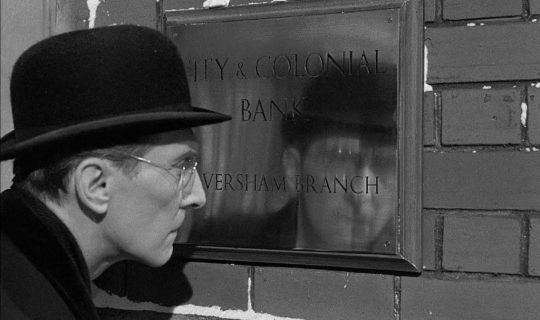
Uptight, unpleasant bank manager Harry Fordyce (Peter Cushing) is the boss from hell to his employees, but to criminal extraordinaire Gore Hepburn (Andre Morrel), he's the key to a successful heist. Posing as an insurance representative to get access to Fordyce's office, Hepburn tells the manager he's holding his wife and child, whose lives will be forfeit if he doesn't help him relieve the bank of ninety thousand pounds.
Ho, ho, ho, guess who's got a new Christmas classic to enjoy every year? Cash on Demand is not only a strangely enervating riff on A Christmas Carol's basic set-up (a miserable man is spiritually redeemed through an encounter with ghosts-- or in this case, bank robbers), but it's one of the best, tightest one-location thrillers I have ever seen. I genuinely had no idea where the story was going and found myself in absolute agony as the noose grew tighter around our protagonist's neck. It's a testament to both the writing and Peter Cushing's detailed, very human performance that this film is the emotionally powerful piece of work that it is, and not just a fun, clockwork heist yarn.
Letter from an Unknown Woman (dir. Max Ophuls, 1948)

While trying to evade a duel, an aging playboy (Louis Jordan) receives a letter from a dying woman (Joan Fontaine) who claims he was the love of her life. The letter recounts the details of their love affair, which was the centerpiece of this woman's life and only a mere erotic interlude in his.
The best way to describe this movie is lush romantic melodrama married to a bitter, emotionally brutal tale of a life wasted. The movie is heartbreaking but beautifully shot and performed. I’m not always the biggest fan of Fontaine, but she is fantastic here. Also, I need to watch more Max Ophuls.
Sudden Fear (dir. David Miller, 1952)
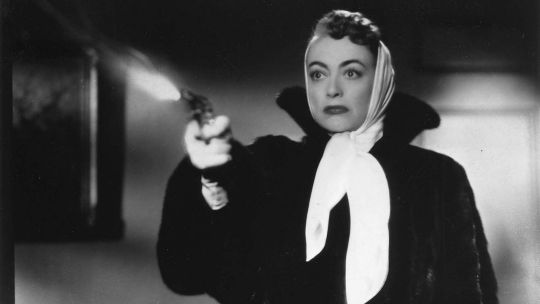
A middle-aged playwright (Joan Crawford) thinks she’s found love with a would-be matinee idol (Jack Palance)—instead she realizes she’s being targeted by her new hubby, who only wants her wealth. But he mistakes her emotional vulnerability for a lack of discernment—and a lack of desire to get even.
I like my women-in-peril thrillers when they feature clever heroines driven to survive whatever nightmare their antagonists throw at them and Sudden Fear is amazing in this regard. I know everyone loves Joan Crawford best in Mildred Pierce, but I was floored by her performance here, especially in the dialogue-free scenes. There are campy moments (which I adore), but the story is emotionally compelling and I not only wanted Joan's character to survive, but to thrive post-shitty marriage.
Thieves Like Us (dir. Robert Altman, 1974)
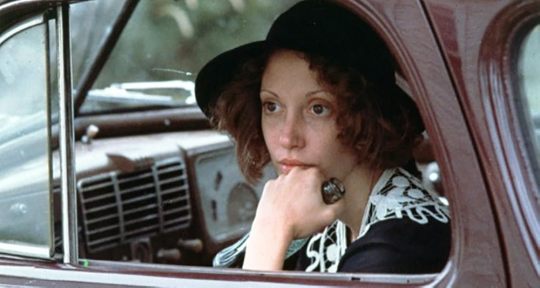
Young lovers Bowie (Keith Carradine) and Keechie (Shelley Duvall) yearn for a white picket fence, a quiet porch, and a case of Cokes (probably because that's all they drink in this film). Too bad Bowie is an escaped convict tied up with bank robbers. Too bad it's the Great Depression. At least there's plenty Coke. Want a Coke?
Most films set in the past do not as painstakingly recreate bygone worlds as strongly as Thieves Like Us. Set in Depression era Mississippi, this film captures the harsh, bleak reality and romantic, consumerist fantasies of its star-cross’d leads, played with sensuous naivete by Keith Carradine and the late, great Shelley Duvall. This is more than just yet another Bonnie and Clyde riff—it’s a tragedy about the elusive American Dream, with snippets of radio music, programs, and ads acting as a Greek chorus in a truly inspired touch. Robert Altman can be an acquired taste, but this is easily my favorite of his films to date.
Targets (dir. Peter Bogdanovich, 1968)
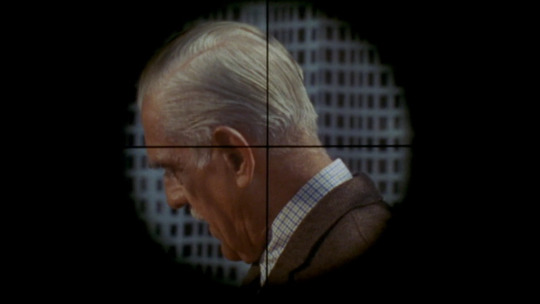
The paths of an aging horror star (Boris Karloff) and a psychotic mass shooter (Tim O'Kelly) cross at a drive-in theater.
Targets was not what I expected: it's a threeway character study between the disheartened horror star, the psychotic shooter, and 1960s America itself. To be honest, you could remake this movie now with a former ‘80s slasher star making the same musings and it would still seem credible—but then of course, you wouldn’t have Karloff in one of the best performances of his career. Targets is rendered even more chilling by its docudrama style. The violence shown isn’t sensationalistic, but presented in clinical detail, making it feel more authentic. Gorier films haven’t frightened me as much as this slow-burn character study.
Losing Ground (dir. Kathleen Collins, 1982)
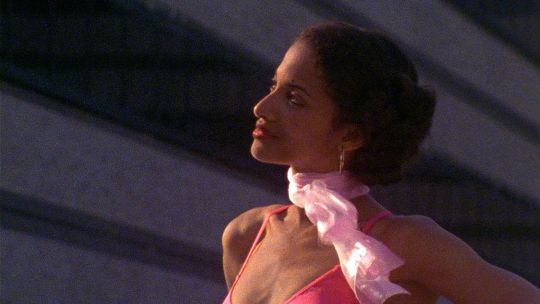
Despite finding pleasure in research and theory, philosophy professor Sara Rogers (Seret Scott) envies the escatic nature of her painter husband, Victor (Bill Gunn). Their difference in temperaments and Victor's adulterous straying also strain the marriage. However, once Sara takes a job performing a sensuous, emotional role in a student film to get in touch with her own artistic side, Victor grows suspicious and jealous in turn.
Losing Ground was sold to me as a film about a crumbling marriage, but it's more than that. It might be more accurate to call it a portrait of self-discovery, a woman extending beyond her comfort zone to live more fully. I found myself strongly relating to Sara-- like her, I have a creative side I've often been timid to share, being more comfortable with the mind than the body. Being an independent film, it eschews the Hollywood histrionics and melodrama that would normally accompany this subject matter and it's paced perfectly at 90 minutes. Though filmed in the early '80s, the film only played the film festival circuit and never enjoyed a proper theatrical release. Only in 2015 was it rediscovered and then released on home video. The director Kathleen Collins died young, but this film stands a testament to her passion and talent.
Cactus Flower (dir. Gene Saks, 1969)
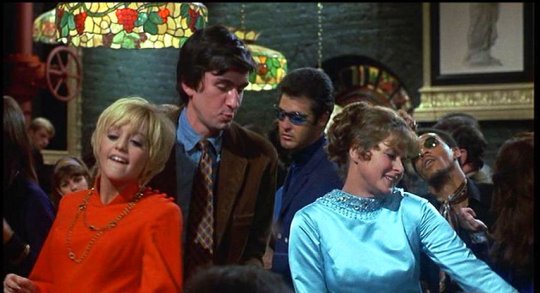
A middle-aged dentist (Walter Matthau) who poses as a married man to fend off romantic commitment decides to buckle down and wed his much younger girlfriend (Goldie Hawn, looking like a mod Tinker Bell). However, when she insists on speaking with his made-up wife, he recruits his no-nonsense nurse (Ingrid Bergman) into the charade.
Cactus Flower is what I often call a transitional film: released in the late ‘60s, it has one foot in the classical style of Old Hollywood and another in the more liberated counterculture that was shooting out hits like Easy Rider and The Graduate. Directed with unexciting competence by Gene Saks, Cactus Flower’s success largely comes from Ingrid Bergman, Goldie Hawn, and Jack Weston. Bergman I could watch in anything, so I’m biased perhaps, but she walks the fine line between funny and touching as the lonely woman who finds emotional liberation through her roleplaying. The scene where she gets groovy on the dance floor is a highlight of her entire screen career and no, I AM NOT KIDDING.
The Black Room (dir. Roy William Neill, 1935)
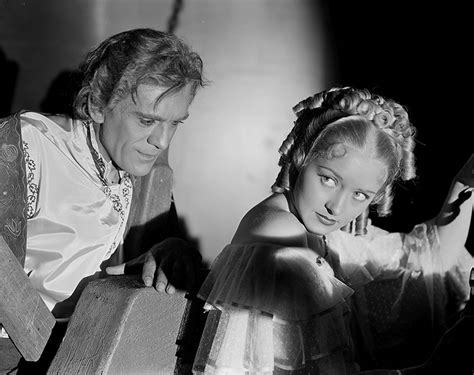
Two aristocratic brothers (both Boris Karloff) are at odds over the love of a young woman (Marian Marsh) and an ancient prophecy forecasting the end of their bloodline.
Boris Karloff dives into a double role in this deliciously gothic melodrama. Columbia pulled out all the stops for this one: it drips with sumptuous set design and expressionistic lighting. I was particularly taken by this film’s slightly tongue-in-cheek approach to a more 18th century mode of gothic terror. It goes for full-blooded melodrama with its innocent maidens, secret dungeons, lecherous villain, and ancient curses. It’s as close to a 1930s Castle of Otranto adaptation as we’ve got and by God, I'm grateful for its existence.
Freud: The Secret Passion (dir. John Huston, 1962)
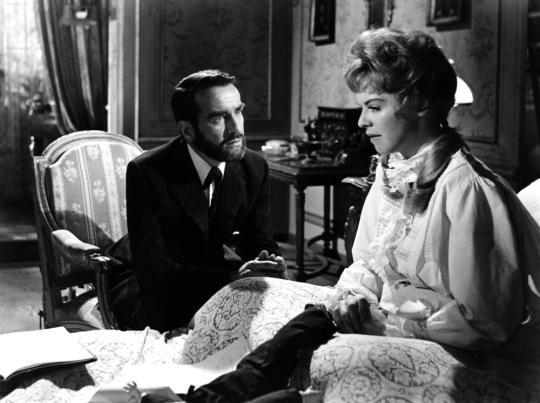
In the late 1880s, young psychiatrist Sigmund Freud (Montgomery Clift) probes into the inner lives of his "hysterical" patients to discover the roots of their mental illnesses. However, these journeys into the subconscious worlds of others bring him into uncomfortable contact with his own demons.
Listening to a podcast episode on John Houston’s Key Largo led me to works of his I hadn’t heard of, such as Freud. I was initially skeptical it could be good. Biopics are my least favorite genre, but this film isn’t so much a biopic as a psychological drama in which Freud is the protagonist and some of his ideas are illustrated through his interactions with the other characters. Instead of wasting time being some melodrama ABOUT Freud the man (the route most biopics go regarding their subjects), it’s about his theories and philosophy, which is a far more interesting approach. The result is a probing, intellectual work. I’m not sure how close Montgomery Clift’s characterization is to the real Freud, but the real star of the show is Houston’s direction, a resurrection of German expressionist aesthetics blended with stark realism.
Paris is Burning (dir. Jennie Livingston, 1990)

This documentary covers 1980s NYC ball culture, where Black and Latino members of the LGBT+ community vogue and perform.
Documentaries are not usually my thing, but Paris is Burning was a longtime resident of my watchlist and I am glad I finally got around to seeing it. It has a time capsule quality, capturing a long-vanished 1980s New York City and the LGBT+ community living there at the time. Obviously, there is a lot of meditation on gender identity, sexuality, and the importance of community in a world hostile to your very existence, but I was also interested by the film's presentation of the materialism and consumption of the Reagan era.
Candyman (dir. Bernard Rose, 1992)
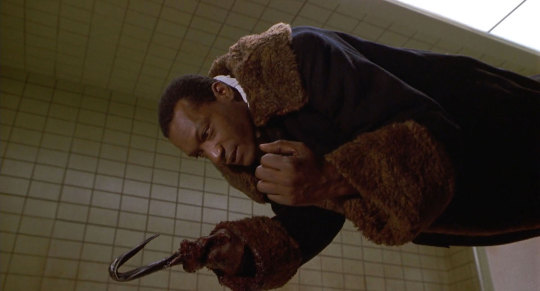
A graduate student (Virginia Madsen) studying urban myths unwittingly summons the Candyman (Tony Todd), the hook-handed ghost of a Black painter who was lynched decades ago.
I expected fun slasher nonsense and instead got a gorgeous, unsettling, modern gothic masterpiece that only occasionally dips its toes into schlock. Candyman is ethereal in all the right ways despite being suffused with despairing urban gloom. I was not surprised to find the script was adapted from a Clive Barker story—like Barker’s The Hellbound Heart (adapted into the Hellraiser films), Candyman is chilling yet eerily beautiful. The moment I finished watching it, I knew this was one I would be itching to revisit. There’s just so much going on regarding race, class, and memory in America. Also, Tony Todd’s voice is a damn treasure.
Merrily We Go to Hell (dir. Dorothy Arzner, 1932)

An alcoholic playwright (Frederic March) and his long-suffering wife (Sylvia Sidney) decide to have an open marriage. It doesn't work out well for either of them.
Merrily We Go to Hell is a sneaky piece of work. Reading the synopsis, one expects the usual salacious pre-code melodrama. The first scenes even resemble your usual romantic comedy, with our central couple having a meet-cute. The actual movie is much more complicated. It's about a married couple thinking love is enough to make their union work despite the husband's alcoholism. However, this idea proves erroneous and attempts to numb the pain through hedonism and extramarital vengeance just pour gasoline on the fire. The emotional honesty here is astonishing and even the "happy ending" isn't so uncomplicated when you think about it. So far, this is my favorite film of director Dorothy Arzner.
Up the Down Staircase (dir. Robert Mulligan, 1967)
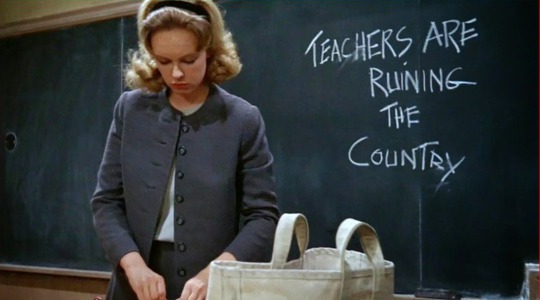
An idealistic young teacher (Sandy Dennis) gets her first position at an inner-city high school. However, she finds her enthusiasm worn down by the school system's bureaucracy and the many psychological troubles of her students and fellow faculty.
Ever since I watched Four Seasons a few years ago, I’ve been intrigued by Sandy Dennis. No matter the role, I find her eccentric yet vulnerable screen presence compelling. Up the Down Staircase was Dennis’ first starring vehicle and an unsentimental look at the teaching profession. Having worked as a teacher and in similar jobs in the past, I related strongly to the main character’s compassion fatigue and her frustrated desire to help make her community a better place. While not a cheery film, it is ultimately an optimistic one, even if that optimism is cautious. And of course, Dennis is damn great as always, whetting my appetite for more of her work.
They Shoot Horses, Don’t They? (dir. Sydney Pollack, 1969)
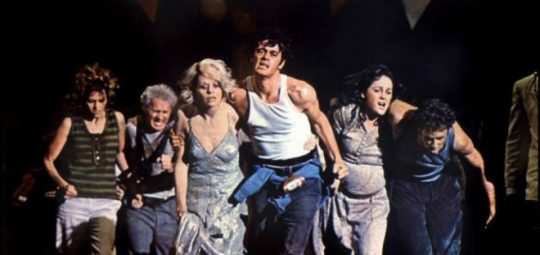
In the thick of the Great Depression, a group of desperate contestants sign up for a grueling dance marathon with a hefty cash prize. Greed, sexual exploitation, health problems, and crushing despair eventually complicate the exhibition.
This movie is so bleak you’ll be just as exhausted as the characters by the tragic finish. I know that doesn’t sound like much of a recommendation, but this is powerful stuff. It does what a great tragedy should do: make you emphasize with the characters and go out into the world more empathetic toward the people around you and more critical of a society in which such awful conditions could be permitted. And like Targets, it’s depressing that this movie’s themes remain relevant to American culture.
Flash Gordon (dir. Frederick Stephani and Ray Taylor, 1936)
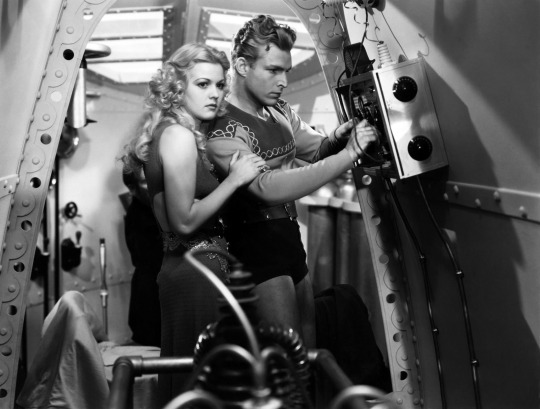
A himbo polo player (Buster Crabbe), a middle-aged scientist in hot pants (Frank Shannon), and an ingenue in a blonde wig (Jean Rogers) must save the Earth from a galactic emperor.
Yes, I’m counting a film serial as a single unit on this list. In this corny, breathless saga can be found the seeds of so many modern blockbuster spectacles. The old school space opera aesthetic is always a joy and I love seeing what George Lucas borrowed from the comic book plot and fantastic images for his Star Wars films. Also, the serial is surprisingly horny for a product released after the death knell of the pre-code era, so that’s fascinating too. I watched the episodes, one a night, usually before a feature film, to recreate at least in part the conditions in which old serials were viewed. I highly recommend that approach if you're interested in watching these kind of films-- NEVER binge them.
Silkwood (dir. Mike Nichols, 1983)
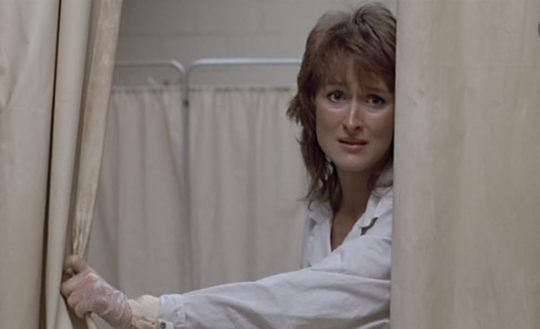
Karen Silkwood (Meryl Streep), a union activist and metallurgy worker at a plutonium processing plant, discovers both she and many of her co-workers have been contaminated with high levels of radiation due to blatant safety violations. Rather than remedy the problem, her employers are determined to keep her quiet, but Karen refuses to back down.
Meryl Streep's performance in Silkwood finally showed me what all the hype around her is about. What an astonishing, natural performance-- I forgot I was watching an actor every moment. As for the overall film, it's one of the stronger docudramas out there (as this film was based on a true story). It isn't just a preachy message piece and it allows Silkwood to be both a heroic figure and a flesh and blood human being with flaws like anyone. The domestic drama involving her lover (Kurt Russell) and lesbian roommate (Cher, who also gives an incredible performance) is almost as compelling as the main story. Though released in the early '80s, it feels like a late manifestation of the paranoia thriller genre of the decade before.
Love with the Proper Stranger (dir. Robert Mulligan, 1963)
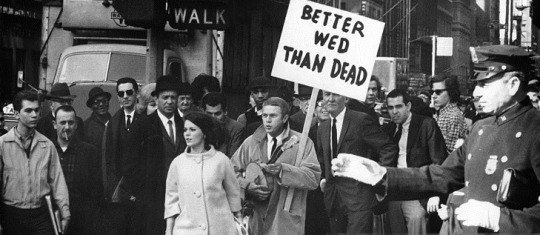
When a one-night stand with a jazz musician (Steve McQueen) leaves her pregnant and at risk of upsetting her very Catholic family, an innocent sales clerk (Natalie Wood) tracks down her lover and demands he help her get an abortion.
Love with the Proper Stranger is such a unique piece of work that I can forgive the elements that dissatisfy me (like the ending). Wood and McQueen's romance starts out acidic and slowly becomes tender over the course of their bizarre misadventure, and the film itself shifts through several moods. Sometimes it feels like an urban drama, other times a romantic comedy. But it somehow holds together, perhaps because of the chemistry between the lead actors.
What were your favorite film discoveries in 2024?
#the window#my neighbors the yamadas#a new leaf#letter from an unknown woman#thieves like us#targets#freud the secret passion#candyman#sudden fear#cactus flower#flash gordon#the black room#up the down staircase#they shoot horses don't they#cash on demand#losing ground#paris is burning#merrily we go to hell#thoughts#silkwood#love with the proper stranger
29 notes
·
View notes
Text
Christmas Carol-cember Day 3
When you name a cartoon character “Scrooge McDuck,” you’re pretty much guaranteed to have that person play Ebenezer Scrooge.

If you aren’t? Then what are you even doing when this golden opportunity is literally gift wrapped for you? It’s like making a character named “Spider-Man" and he has nothing to do with arachnids. Wasted opportunity.
This 1983 short film truly was a testament to the animation team at the Disney Company, especially for a time when the higher ups were strongly considering shutting down the animation department after a slew of films distributed by the company that weren’t major financial draws. Even more impressive to consider this short film was conceived by the late Disney Legend Burny Mattinson, who passed away last year after a 70-year career at the Walt Disney Company. He started out working as an in-betweener and character animator for 30 years until he grew bold and sent a pitch to Disney’s former CEO, Ron Miller. Miller, according to Burny, tried to strong-arm him over the pitch but Burny held his ground until Miller finally relented, admitted he actually liked the pitch and immediately approved the project.
While the short was originally intended to be released on Christmas 1982, an animator strike delayed the short from it’s Christmas release, forcing Disney to show the short before a re-release of 1977’s “The Rescuers.” Funny enough, the last Mickey Mouse cartoon released in theaters was 30 years prior under RKO Radio Pictures. The short was critically received upon release, even garnering Mattinson an Academy Award nomination. As a result, Mattinson found himself a co-director on a feature film for “The Great Mouse Detective,” bringing along two character animators he had worked alongside.
But the story of John Musker and Ron Clements and their success within the Disney Company is a story for another day.

Naturally since this is an animated short film, many story beats from the original story had to be dropped. Although Scrooge’s nephew remains in the story, his connection to Scrooge’s sister Fran is not present. Nor is the iconic moment of the Ghost of Christmas Present showing “Want” and “Ignorance" to Scrooge as he warns they are the children of Mankind.
But I suppose that’s the tricky thing with adaptation. How much to keep vs how much not to keep.
I was about to ask why Fred was even here until I learned that Burny Mattinson’s dream project was to have the “Big Five” of Disney here. Mickey Mouse, Minnie Mouse, Donald Duck, Goofy and Pete. While many of the original voice actors had passed on, Clarence Nash was still alive though he had to limit performing the Donald Duck voice as it strained his voice. A rumor that may or may not be true tells that the voice directors brought Nash in and worried if he could still do the voice until someone spilled coffee on Nash’s arm. As the story goes, Nash cursed out in the Donald voice and the voice directors supposedly just said “yup, he’s still got it.”
He died two years later, marking this short the last time one of the surviving original Disney voices would perform their characters for a new animated short.
But of course, this is about performances of Scrooge. How does this one measure, especially when it’s animated and has more to do in a short time?
Alan Young as Scrooge McDuck is, to put it best, just a perfect combination of what you want out of the character of Ebenezer Scrooge.

His Scottish drawl and delivery of his lines makes his Scrooge feel genuine.
Someone that is cold, but clearly able to comprehend sympathy.
It also helps that Alan Young makes Scrooge’s greed hilariously lacking in self-reflection; my favorite line being “In his (Marley) will, he left me enough money to pay for his tombstone. Yet I have him buried at sea!”
It’s a funny take but Young captures the greed that befits the Scrooge character, but also demonstrates the humanity that is clearly inherent. Such as the remorse when he reflects on losing Isabelle or the dawning realization that his penny-pinching causes direct harm to Tiny Tim. Heck, that sequence of Scrooge seeing Mickey Mouse shed a tear before laying Tim’s crutch against his tiny grave, all done without words, is beautifully done. Huge props to Mattinson and his animation team for pulling that off.
Even more praise is deserved with the sequence that has become something of an image of nightmares for some kids who saw this: Pete tossing Scrooge into an open grave as smoke and fire bellows out from below while Scrooge pleads for a second chance, complete with Will Ryan’s cackle at Scrooge’s terror.
youtube
Even if it kind is lifted from another Christmas Carol movie, but we’ll get to that one in due time.
Revisiting this short film after all these years and reading up on the passion that the late Burny Mattinson had to make this labor of love at a time when the Disney Company shut down the short films department as a cost-saving measure and was considering doing the same to the animation department as well, really allowed me to appreciate this cartoon more than I did as a kid.
The reunion of many Disney characters who were most likely forgotten by that time (Willie the Giant or Ratty and Moley come to mind) and given exposure to an new audience while also introducing a new generation to a voice for Scrooge McDuck who would ingratiate himself with the character until his death in 2016.
As far as adaptations of the Charles Dickens story go, this one is perfectly suitable for all age groups and I would easily recommend it for parents who want to introduce their children to the Dickens story without necessarily traumatizing them.
It’s the right balance of Christmas cheer and scares to get them into the story.
“Mickey’s Christmas Carol” is available for streaming on Disney+.
Next time? We return to television with a Scrooge not from England, but from America...

#reviews#christmas carol#ebenezer scrooge#disney#scrooge mcduck#Mickey Christmas Carol#mickey mouse#mickey and friends#goofy#minnie mouse#Youtube
12 notes
·
View notes
Text
I revisited Jurassic Park 2 and 3 over the weekend.
Jurassic Park 2 The Lost World is not a good film. It’s barely passable as escapist fun. It feels like Spielberg’s heart isn’t in it and the script is weird and uneven. It’s too busy with too many characters and no real narrative drive. Except for the first, big set piece, there’s not much action that doesn’t feel repetitive or underwhelming. Poor Goldblum has to carry the whole film on his back and he seems annoyed to be given that task. I think he knows it and quietly projects this.
I’ve been a long time defender of JP3 (2001) and it was thoroughly enjoyable to watch it again. I love this film because the filmmakers know what this is. It’s a monster movie with dinosaurs and they do exactly the right thing. They make a very short (it’s 92 minutes WITH END CREDITS!) and succinct film that does what RKO did with the original King Kong in 1933. They eliminate all of the flab and keep only what’s essential. It’s not trying to change the world. It’s trying to make a crackling entertainment and it succeeds! It has a clever and hair raising sequence with fog and pterodactyls that is one of the best moments in the whole series. The plot is simple and the characters don’t spend too much time yapping about stuff. It just keeps moving along and it does so with solid direction and energy.
Seeing them back to back it’s clear that Lost World was just a mess and JP3 was Universal’s way of righting the ship. It’s a shame people either dump on or forget about JP3. I think all genre movies of this kind should be handled with that approach. The Peter Jackson King Kong is a great example of what NOT to do. It’s long, it’s bloated. It’s too much all the way through.
12 notes
·
View notes
Text
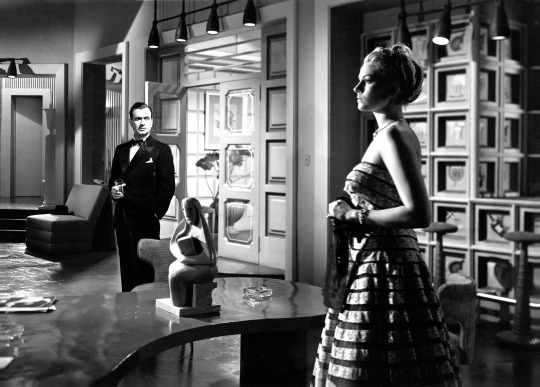
#NoirCity21 opens this Friday, Jan 19, 7:30 PM at Oakland's Grand Lake Theatre with our newest restoration project NEVER OPEN THAT DOOR. Eddie Muller will be signing his books up in the mezzanine, 6pm-7pm. Tix: http://NoirCity.com
Restoration performed by UCLA Film & Television Archive.
Program notes follow.
FRIDAY, JANUARY 19:
7:30
World Premiere FNF Restoration!
NEVER OPEN THAT DOOR | NO ABRAS NUNCA ESA PUERTA
Argentina, 1952. Estudios San Miguel. 85 minutes
Screenplay by Alejandro Casona, from two short stories by Cornell Woolrich (William Irish)
Produced and directed by Carlos Hugo Christensen
More noir films have been based on the stories of Cornell Woolrich than any other writer, and NOIR CITY is proud to present this brand-new restoration of one of the best of those adaptations. In “Someone’s on the Phone,” Ángel Magaña plays a man bent on avenging the death of his sister, driven to suicide by gambling debts. In “The Hummingbird Comes Home,” Roberto Escalada portrays a racketeer who brings the gang to his boyhood home to lay low after a robbery. His blind madre doesn’t approve. Originally a three-part anthology of Woolrich tales, Never Open That Door was released separately from the 73-minute If I Should Die Before I Wake, also adapted by Casona and Christensen. Benefitting from the incredible cinematography of Pablo Tabernero, this is one of the most evocative realizations of Woolrich ever produced, featuring masterful sequences of sustained suspense. Said Buenos Aires film critic Horacio Bernades, “Rarely has an Argentine film been more purely cinematic than this.”
CAST: Someone on the Phone: Ángel Magaña (Raúl), Renée Dumas (Luisa), Diana de Córdoba (Nelly), Nicolás Fregues (money lender), Pedro Fiorito, Orestes Soriani, Percival Murray, Rosa Martín , Arnoldo Chamot. The Hummingbird Comes Home: Roberto Escalada (Daniel), Ilde Pirovano (the mother), Norma Giménez (María), Luis Otero (Juan)
9:30
STREET OF CHANCE
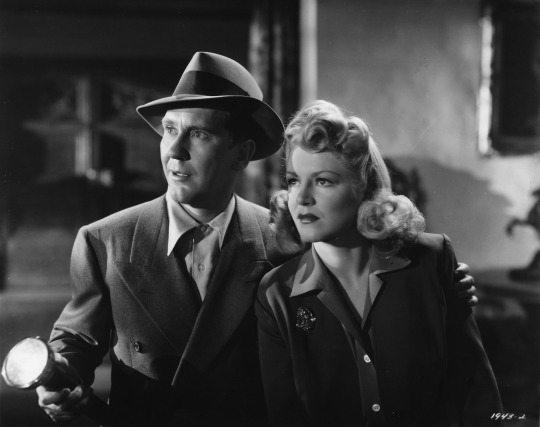
United States, 1942. Paramount [Universal]. 74 minutes
Screenplay by Garrett Fort, based on the novel The Black Curtain by Cornell Woolrich
Produced by Burt Kelly. Directed by Jack Hively
The first case of amnesia in the film noir era comes with a typically intriguing Woolrichian twist. Frank Thompson survives a near fatal accident only to have the shock partially restore his memory! He realizes he’s lived the past several years as someone other than his true self. With the help of his incredulous girlfriend Ruth, Frank embarks on a nocturnal quest to determine his true identity. This modest offering from the B-unit at Paramount benefits from some A-list contributors, principally stars Burgess Meredith and Claire Trevor, and director of photography Theodor Sparkuhl, whose contributions to the look of early ’40s noir have gone largely unheralded. A wonderful gallery of supporting characters skitter and sneak through Frank’s waking nightmare, well rendered by journeyman director Jack Hively who had previously helmed many entries in RKO’s mystery series The Saint.
CAST: Burgess Meredith (Frank Thompson), Claire Trevor (Ruth Dillon), Louise Platt (Virginia Thompson), Sheldon Leonard (Joe Marucci), Frieda Inescort (Alma Diedrich), Jerome Cowan (Bill Diedrich), Adeline deWalt Reynolds (Grandma Diedrich), Arthur Loft (Sheriff Stebbins), Clancy Cooper (Burke), Ann Doran (Miss Peabody), Paul Phillips
#film noir#eddie muller#noir city#noir city 21#film noir festival#film restoration#don't open that door#street of chance#cornell woolrich
6 notes
·
View notes
Text
Fay Wray - The First Scream Queen


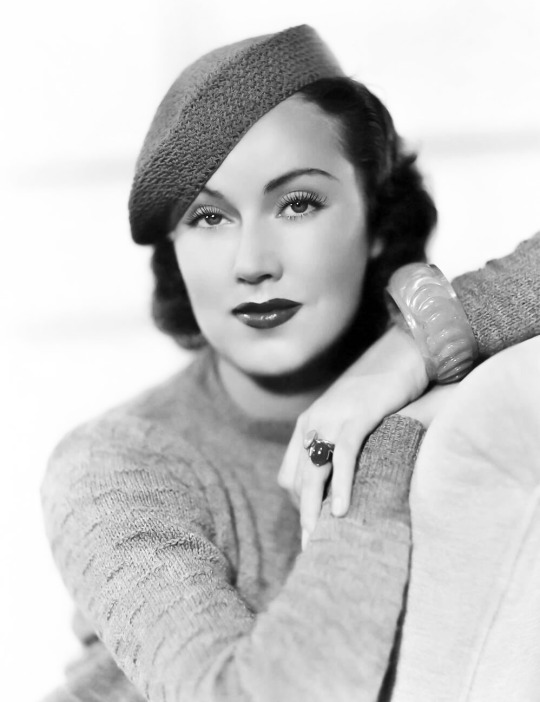
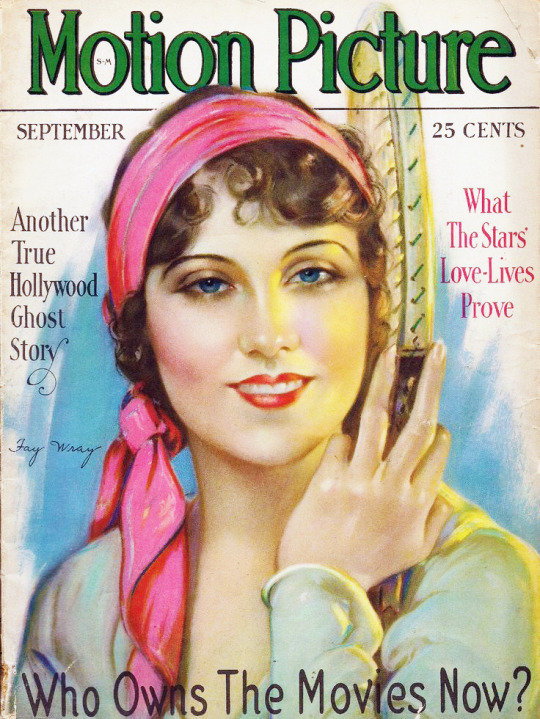
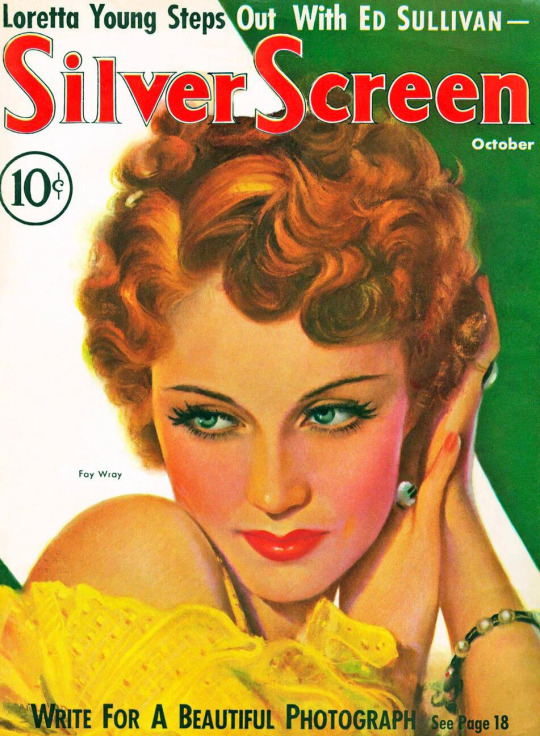
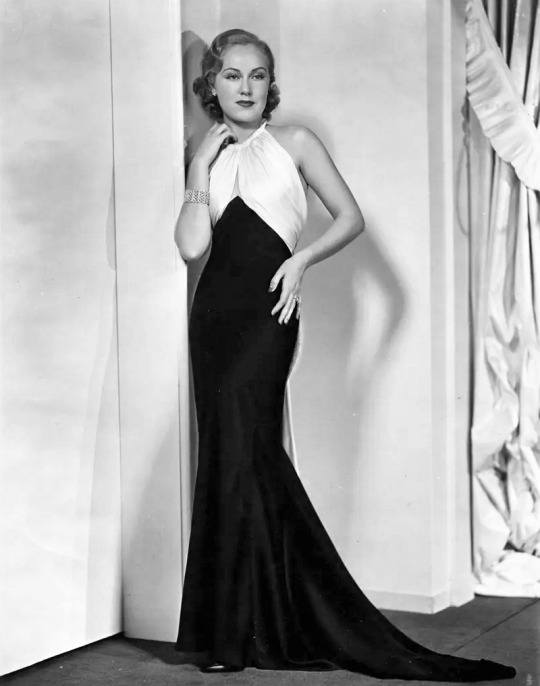
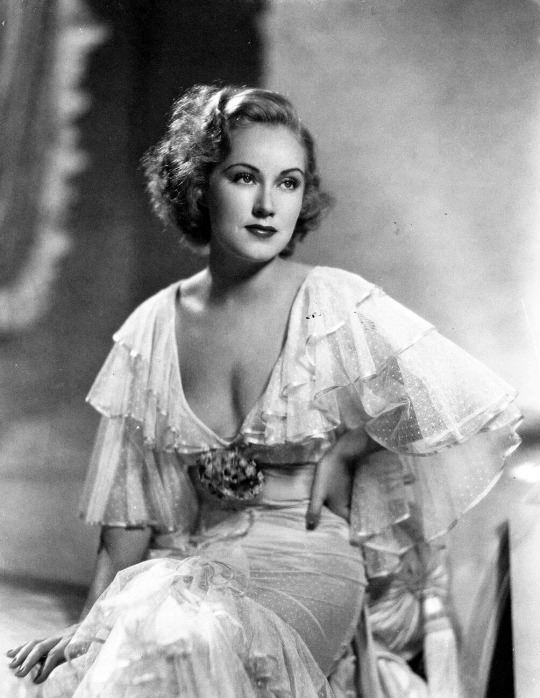
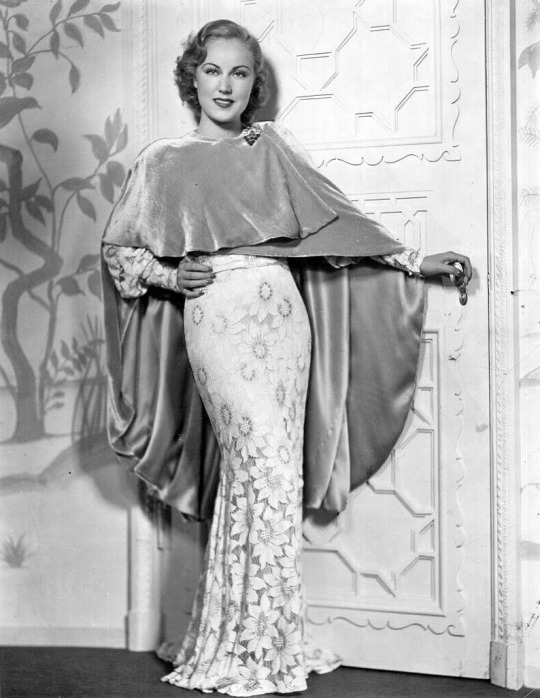

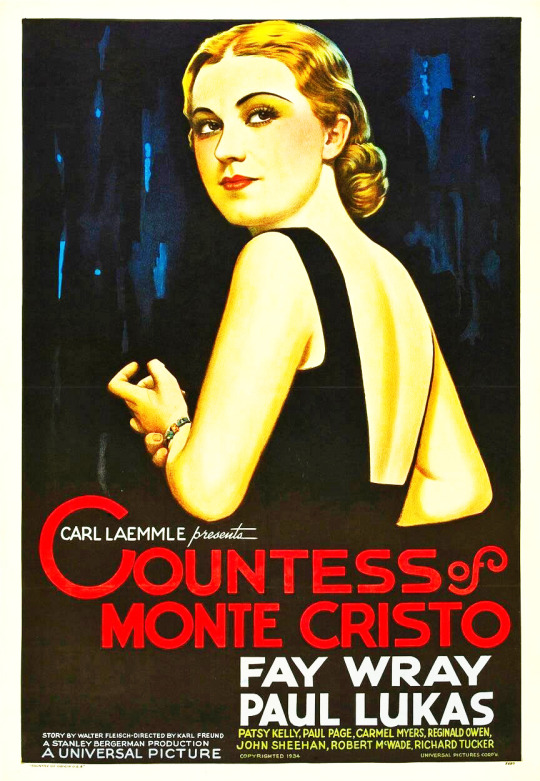
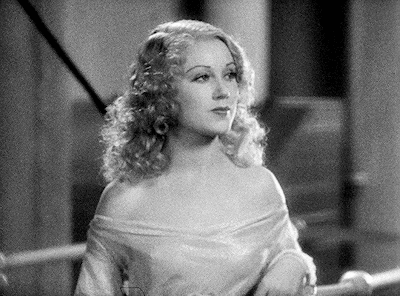
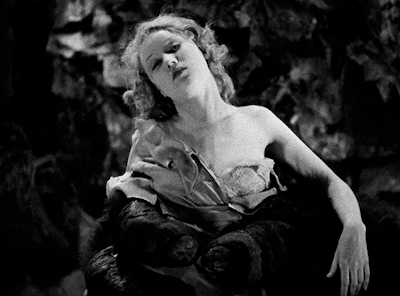
Vina Fay Wray (born in Cardston, Alberta, on September 15, 1907) was a Canadian-American actress who attained international recognition for her roles in in horror films. Because of this, she has been dubbed as "The First Scream Queen".
After returning to the US, the Wray family relocated to Hollywood, where Wray attended Hollywood High School. In 1923, she appeared in her first film at the age of 16, when she landed a role in a short historical film sponsored by a local newspaper.
After appearing in more minor film roles, Wray gained media attention after being selected as one of the "WAMPAS Baby Stars" in 1926. This led to her being contracted to Paramount Pictures as a teenager, where she made more than a dozen feature films.
After leaving Paramount, she signed deals with various film companies. Under these deals, Wray was cast in several horror films, but her best known films were produced under her deal with RKO Radio Pictures, including The Most Dangerous Game (1932) King Kong (1933).
Wray died in her sleep of natural causes at 96 years of age in her apartment in Manhattan. Two days after her death, the lights of the Empire State Building were dimmed for 15 minutes in her memory.
Legacy:
Named as one of the WAMPAS Baby Stars in 1926
Granted an honorary princess status and given the name "Little Beaver," by the Kainai Nation in 1967
Became the namesake of a park and a fountain in Cardston, Alberta, her birthplace, during the town's jubilee in 1967
Presented with the Special Award at the Saturn Awards by the Academy of Science Fiction, Fantasy & Horror Films in 1975
Published an autobiography, On the Other Hand: A Life Story, in 1989
Awarded the Women in Film Crystal Award in 1989
Was the Guest of Honor in 1991, at the 60th birthday of the Empire State Building
Honored with a Legend in Film award at the 2003 Palm Beach International Film Festival
Received a star on Canada's Walk of Fame in 2005
Became one of the first four entertainers to be commemorated by Canada Post by being featured on a postage stamp in 2006
Listed at 84 in Playboy's "100 Sexiest Women of the 20th century" in 2012
Has a star on the Hollywood Walk of Fame for her contributions in motion pictures at 6349 Hollywood Blvd
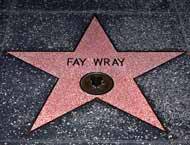
#Fay Wray#Ann Darrow#King Kong#Scream Queen#Scream Queens#The First Scream Queen#The Original Scream Queen#Silent Films#Silent Movies#Silent Era#Silent Film Stars#Golden Age of Hollywood#Classic Hollywood#Film Classics#Classic Films#Old Hollywood#Vintage Hollywood#Hollywood#Movie Star#Hollywood Walk of Fame#Walk of Fame#Movie Legends#Actress#hollywood actresses#hollywood icons#hollywood legend#movie stars#1900s
5 notes
·
View notes
Text




Carol Tevis in Flirting in the Park (1933)
1 note
·
View note
Text
Flirting in the Park (1933)
#flirting in the park 1933#grady sutton#eddie j nugent#eddie j. nugent#carol tevis#june brewster#donald haines#this film was the funniest among 'blonde and redheads' series#rko short film#rko short comedy#rko comedy
0 notes
Text
Coincidental Disney Logo Trivia...

The current Disney logo celebrates the enterprise's 100th year of existence... It's a lovely, full-length intro full of neat stuff. A more ground-level tour than a pan down from a starry sky...
It first appeared, in full, before STRANGE WORLD in movie theaters this past autumn. They got the ball rolling early. The logo had also appeared - in cut-short form - in a handful of trailers at the time as well, like for the LITTLE MERMAID remake, ELEMENTAL, and the trailer for DISENCHANTED. D23 attendees were treated to it first before that...
STRANGE WORLD being the first film to bear the new logo, which will likely be used for another decade or so without the "100" next to "Disney", is curious... The film was a massive flop, and one that was largely left for dead by the company.
Wouldn't be the first time...
The first two pictures to introduce the iconic Walt Disney Pictures logo, that laid the groundwork for all logos thereafter, the very thing so many people associate with this company's movie library... Also flopped...
Those movies were... RETURN TO OZ and THE BLACK CAULDRON, both released a month apart from each other in the summer of 1985...

Believe it or not, the Disney studio never had a proper logo introduction for DECADES...
Early Disney cartoon shorts had title cards letting the audience know who the picture was coming from, which was par for the course for most shorts. Walt and Roy Disney had went through a few distributors during the late 1920s and 1930s, notably Celebrity Pictures, Columbia, and United Artists. When Walt was readying his first feature-length film, SNOW WHITE AND THE SEVEN DWARFS, he struck a long-term distribution deal with RKO Radio Pictures. A long-defunct company, but back then a recognizable movie giant, up there with the likes of Paramount, Universal, and 20th Century Fox.
Disney films typically began with an RKO title card, not RKO's actual animated logo sequence depicting a blinking radio tower over a spinning globe. The title card would be stylized to fit with the credits sequence of whatever movie it was. For example, in PINOCCHIO, the RKO logo is carved into wood. For DUMBO, it's a circus poster-looking graphic. And so on, and so forth.
Walt and Roy then broke off from RKO, launching their own distribution company Buena Vista in 1953. Many of the Disney films released from 1954 to 1961, that were not leftover RKO-contract movies and shorts that were released well after the two parties parted ways, opened the same way. A Buena Vista title card that was stylized to look like the opening credits of the respective movie... But by the early 1960s, most Disney movies just used a standard blue gradient logo. This title card's general design layout would be used all the way up until 1984.
"Walt Disney presents" for films made before Walt's passing, and "Walt Disney Productions" for posthumous films, would be the next title card you saw after an RKO or Buena Vista logo. Walt Disney Productions became "Walt Disney Pictures", quietly, in 1983. The first film to be released as a "Walt Disney Pictures" movie was NEVER CRY WOLF. In that film, which is unfortunately a hard one to find, the first thing you see is a bar with serif text saying "Walt Disney Pictures". A title card. No official logo just yet.
Heck, the home video end of things had a logo before the film studio themselves did! Two logos at that!
Disney didn't release a new feature film in 1984 that was under the Disney name. SPLASH and COUNTRY came out in 1984, those were the first two pictures under the company's Touchstone Pictures banner, a banner meant for more adult-oriented films. Then-CEO Ron Miller founded Touchstone, and he'd be replaced by Michael Eisner by the end of the year. Following Eisner's arrival to the company, the rebrand went into full swing... The studio was officially renamed Walt Disney Pictures, the self-distribution company was still Buena Vista, as would be mentioned in a movie's end credits.
So, a new logo was in order...
The logo's first appearance, in short-form, was before a theatrical trailer for THE BLACK CAULDRON that ran in late 1984 before the theatrical re-release of PINOCCHIO. It is unknown if the longer logo preceded PINOCCHIO's opening credits for that re-release, if it did, then that would make it the 1984 Walt Disney Pictures logo.
Anyways, the first film audiences saw it before was RETURN TO OZ... But in short form, with no music!
A month later, THE BLACK CAULDRON came to theaters. It opened with the full logo, with the full 'When You Wish Upon a Star'-inspired jingle that everyone and their brother's dog knows...
Again, two movies that flopped. In fact, all of Disney's mainline 1985 movie releases that weren't Touchstone movies... Just didn't cut it at the box office. These two movies, THE JOURNEY OF NATTY GANN, ONE MAGIC CHRISTMAS... It wouldn't be until the summer 1986 releases of THE GREAT MOUSE DETECTIVE and FLIGHT OF THE NAVIGATOR, two films bearing this logo that did well at the box office.
The revised version of this logo, with more digital-looking glowing light effects and animation, and the arch not overlapping with the "W" in "Walt"... First appeared before a test re-release of THE BLACK CAULDRON under the title TARAN AND THE MAGIC CAULDRON in January 1990, which didn't take off in the few cities it was screened in... Later, in July 1990, it accompanied a very successful re-release of THE JUNGLE BOOK. As for a "new" movie bearing the logo that did well? WHITE FANG, released in January 1991, did okay. It wouldn't be until BEAUTY AND THE BEAST later that year, though, in November... For a genuine big hit...
For this Disney 100 logo, it looks like LITTLE MERMAID will be the first box office success bearing this new logo. It's actually their first mainline Disney theatrical release since STRANGE WORLD... Everything else has been a Marvel movie (QUANTUMANIA, GUARDIANS OF THE GALAXY VOL. 3) or a 20th Century Studios/Searchlight movie (AVATAR: THE WAY OF WATER, CHEVALIER).
Funnily enough, the first film to introduce the previous long-running CGI Disney castle logo?
Big hit. HUGE, record-breaking hit... That was PIRATES OF THE CARIBBEAN: DEAD MAN'S CHEST, from summer 2006...
Maybe when Disney makes a new logo to replace this one in, say, 2040-something... It'll be for a hit movie? I dunno, just something I noticed.
Logo stuff, ya know?
6 notes
·
View notes
Text
MOVIES on TV!
Part 3 ~ The Movies of “Here’s Lucy”

In “Here’s Lucy,” Lucille Ball had a new character, a new family, and a new show - but one thing remained constant, her love of movies! Here are some of the movies (real and imagined) of “Here’s Lucy.”
~FACTUAL FILMS~

“Lucy and Carol Burnett” aka “The Unemployment Follies” (1971)
Carol and Lucy stage a tribute to Hollywood using unemployed actors. The films mentioned and/or feted include:
TO HAVE AND HAVE NOT (1944)
BLUE ANGEL (1930)
CASABLANCA (1942)
42ND STREET (1933)
THE WIZARD OF OZ (1939)
SINGIN’ IN THE RAIN (1952)
ROSE MARIE (1954)

The set is decorated with posters from:
HOLLYWOOD OR BUST (1956)
SAMPSON AND DELILAH (1949)
THE GREATEST SHOW ON EARTH (1952)
SHORT CUT TO HELL (1957)
GONE WITH THE WIND (1939)
UNDER TWO FLAGS (1936)

“Ginger Rogers Comes To Tea” (1971)
Ginger Rogers leaves her purse in a movie theatre where she's gone incognito to see one of her films for the first time. Lucy and Harry discover the purse and hope to get to meet the star in person by inviting her to tea. Instead of working late, Lucy tells Harry that she wants to go to a Ginger Rogers Film Festival. They are showing Tender Comrade (1943) and Flying Down To Rio (1933), two films made at RKO, which eventually became Desilu.

Rogers tells Lucy she has done 73 movies. Rattling off some of Rogers' hits, Lucy adds a sugar cube to Ginger's tea for each title: Top Hat, Roberta, Flying Down To Rio, Follow the Fleet, Shall We Dance, and The Barkleys of Broadway. When Lucy realizes she's put six lumps of sugar in Ginger's tea, Rogers says she only wanted Top Hat and Roberta (two lumps).

Trying to impugn the taste in films of the mystery woman (a disguised Ginger Rogers), Lucy tells her to try back next week and they might be showing Beach Blanket Bingo (1965). This was the fourth of the light comic films set on the California beach starring Frankie Avalon and Annette Funicello.

After dancing the Charleston with Lucy and Kim, Lucy asks Rogers to do a scene from Kitty Foyle, Ginger’s Oscar-winning role. Rogers graciously declines, asking Lucy to become a Katherine Hepburn fan instead!

“Guess Who Owes Lucy $23.50?” (1968)
Lucy loans Van Johnson money to fix his car – but the man turns out to be an impostor. This episode is written for Van Johnson to work in a not-so-subtle plug for their latest film Yours, Mine and Ours (1968) starring Henry Fonda.
VAN IMPOSTER:“I loved working with that kooky redhead.” LUCY: “Personally, I thought she was much too young for Henry Fonda.”
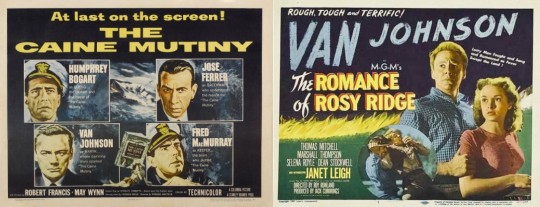
Lucy says she remembers Johnson from his appearance in The Romance of Rosy Ridge (1947). She later tells him she saw the film 17 times! When Lucy is escorted out by the studio guards at Van’s direction, Lucy says that now she’s glad he got court martialed in The Caine Mutiny (1954).
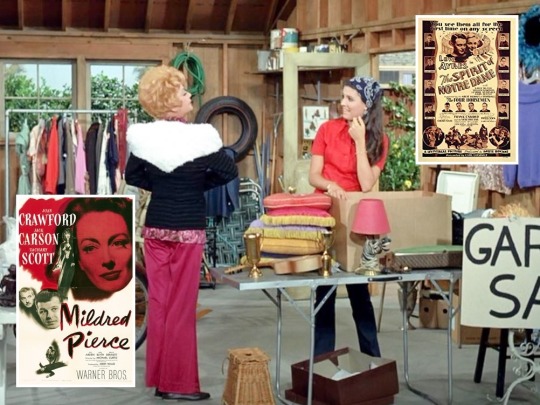
“Lucy and Aladdin’s Lamp” (1971)
When Lucy holds a garage sale, she discovers an old lamp that she believes may be make wishes come true. Lucy pulls out a fur-lined jacket she says was worn by Joan Crawford in Mildred Pierce. The 1945 film won Crawford an Academy Award. Craig says that judging by the shoulder pads she could have worn it in The Spirit of Notre Dame, a 1931 football-themed movie starring Lew Ayres.

“Lucy and Flip Go Legit” (1971)
Lucy takes a temp assignment with Flip Wilson in order to answer his fan mail. When she is caught sneaking into Wilson’s office to ask him a favor, she gets caught and fired. The favor is to appear in a community theatre production of Gone With The Wind (1939) – as Prissy. Lucy plays Scarlett O’Hara, Harry plays Rhett Butler, and Kim takes the role of Melanie Wilkes.
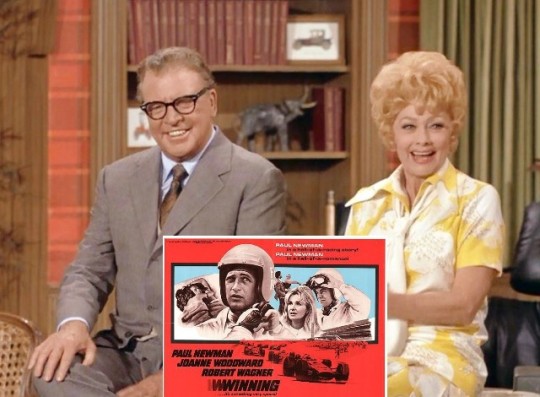
“Won’t You Calm Down Dan Dailey?” (1971)
Lucy gets a job working for Dan Dailey. When he starts to dictate a letter to Paul Newman at Universal Studios, Lucy says she saw Newman on the late show in Winning, a 1969 film about a race car driver.

“Lucy and Rudy Vallée” (1970)
Famous crooner Rudy Vallée is waiting tables to pass the time until his music comes back into style. Lucy convinces Kim to help update his look and sound while Harry gets him a booking at the local teen hangout. When a life-size portrait of Vallée in a raccoon coat is revealed, Vallée says he wore the coat in his first picture, Varsity Hero, a silent picture where critics raved about his singing!
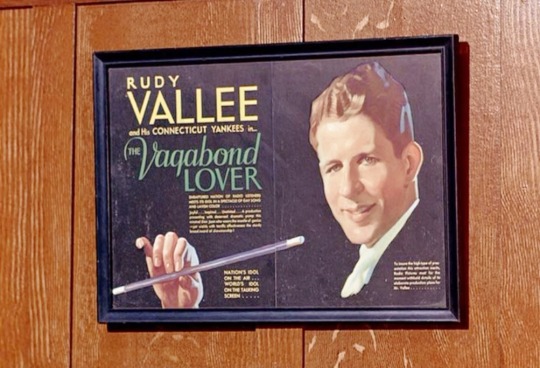
In reality, Vallée’s first film (aside from two shorts playing himself) was The Vagabond Lover in 1929.
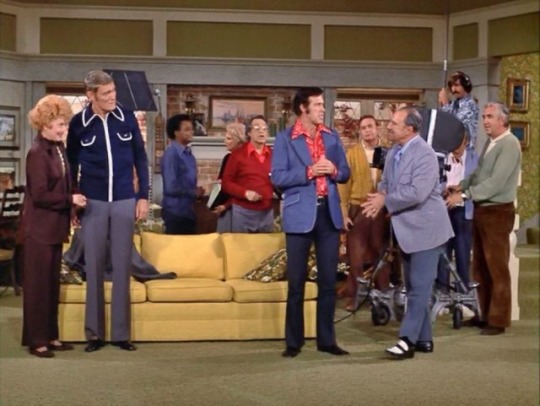
“Lucy and Chuck Connors Have a Surprise Slumber Party” (1974)
Harry rents out Lucy’s home for a movie shoot. After causing several re-takes, Lucy is banished from her own home. When she returns early, she doesn’t know that Chuck Connors is staying overnight – in her bed!
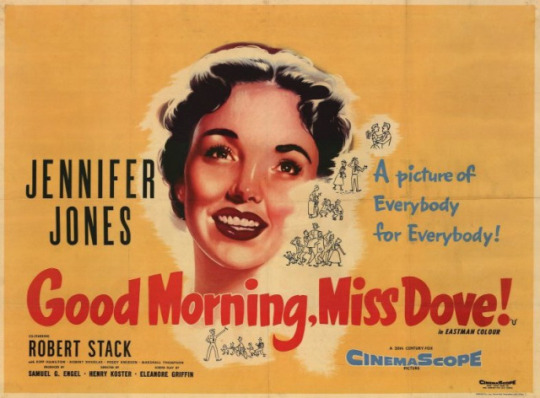
Jerry, the film’s director, tells Chuck that his film Good Morning, Miss Dove starring Jennifer Jones is on television that night. Connors says the film was one of the few times he got to nuzzle something besides a horse. Released in 1955 by 20th Century Fox, the film co-stars Mary Wickes, a frequent guest star on all of Lucille Ball’s sitcoms. It also features Jerry Paris, who directed two episodes of “Here’s Lucy” before being fired, and Robert Stack of Desilu’s “The Untouchables.” Other “Lucy” alumni in the film include Herb Vigran, Hal Taggart, and Arthur Tovey – all appearing uncredited.

“Lucy Meets the Burtons” (1972)
The hotel manager tells Burton that the back door is mobbed by the Elizabeth Taylor Fan Club – Glendale Chapter. Membership to the club requires seeing National Velvet 10 times! National Velvet (1945) was made when Taylor was just twelve years old.
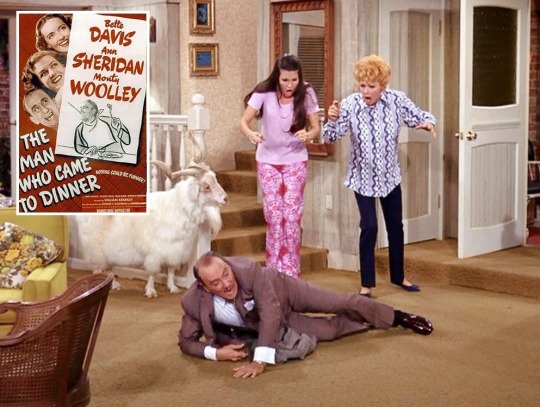
“Lucy’s House Guest, Harry” (1971)
As Harry is finally is finally about to leave, Lucy has a horrible thought: what if he is like Sheridan Whiteside in The Man Who Came to Dinner and falls on his way out and must stay with them even longer? The play, by George S. Kaufman and Moss Hart, opened on Broadway in 1939. It starred Lucille Ball's good friend (and “Here's Lucy” performer) Mary Wickes as Nurse Preen. Wickes was one of several actors who recreated their roles in the 1942 film adaptation.
~FICTIONAL FILMS~

“Lucy, the American Mother” (1970)
Craig makes a film about Lucy, a typical American mother. During the episode, Kim does impressions of Katharine Hepburn in Stage Door (1937), a film that also featured Lucille Ball, Maurice Chevalier in Innocents of Paris (1929), and Bette Davis in The Great Lie (1941).
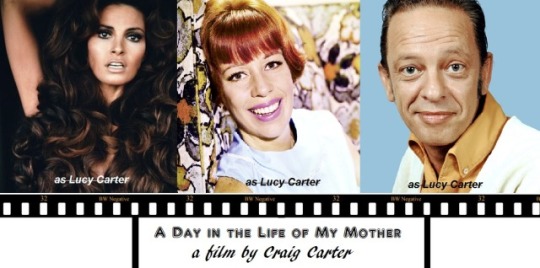
The title of Craig's movie will be “A Day in the Life of My Mother.” When Lucy can't seem to act natural in front of Craig's camera, she suggests he get someone else to play his mother; someone like Raquel Welch, Carol Burnett, or Don Knotts.
~FILM INSPIRATIONS~
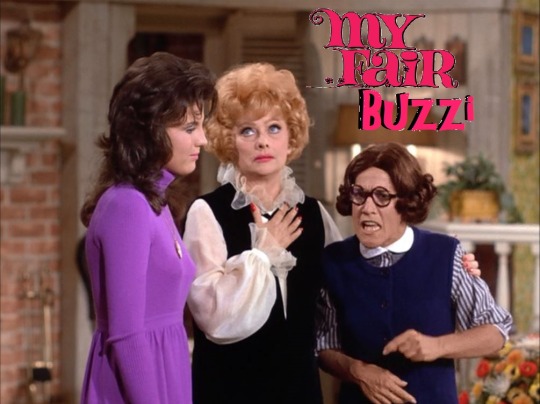
“My Fair Buzzi” (1972)
Kim’s shy and awkward friend Annie (Ruth Buzzi) comes out of her shell in order to audition for a 1920s revue, only to find the director was looking for someone shy and awkward in the first place! The episode title and story of transformation were inspired by the 1956 Broadway musical and 1964 film My Fair Lady, which, in turn, was inspired by George Bernard Shaw’s Pygmalion. Both are mentioned in the dialogue of the episode.

“Dirty Gertie” (1972)
Lucy gets a surprise fruit basket and heads downtown to share her good fortune with her hairdresser. On the street she is mistaken for Dirty Gertie, an apple peddler who just happens to be the good luck charm of a local gangster. This episode was inspired by the 1961 Frank Capra film Pocketful of Miracles in which Bette Davis played Apple Annie, a poor woman reduced to selling apples on the street. The film featured previous “Lucy” co-stars Edward Everett Horton, Jay Novello, Ann-Margret (film debut), Sheldon Leonard, Jerome Cowan, Fritz Feld, Ellen Corby, Benny Rubin, Hayden Rorke, Bess Flowers, Vito Scotti, Bert Stevens, Arthur Tovey, and Romo Vincent.

“Lucy Runs the Rapids” (1969)
The Carters take a road trip in a camper. The episode opens with the soundtrack playing “Breezin’ Along”, the theme song from The Long, Long Trailer (1954), a film starring Lucy and Desi as a couple honeymooning in a trailer.
~FILM FAKES~

“Lucy Cuts Vincent’s Price” (1970)
Price is filming a new horror film titled Who’s Afraid of Virginia’s Wolfman? He says it has the best title since he starred in The Giant Chihuahua That Ate Chicago.
~FILM REFERENCES~
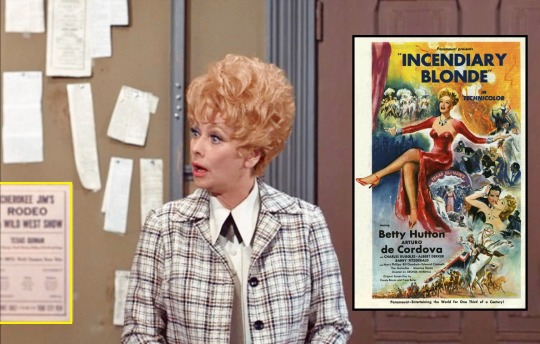
“Lucy, the Cement Worker” (1969)
In Pierre’s the knife thrower’s studio, there is a handbill on the bulletin board for ‘Cherokee Jim’s Rodeo and Wild West Show’, which is a direct reference to the 1945 film Incendiary Blonde starring Betty Hutton as Texas Guinan. The film was directed by George Marshall for Paramount, the same director and studio producing this episode of “Here’s Lucy” 25 years later!

“Lucy in the Jungle” (1971)
When Harry sees baby chimps Fido and Rover, he reminds Lucy and Kim that King Kong started out as a baby, too! King Kong, Hollywood’s tale of a giant ape, was first filmed in 1933, then re-made in 1976 and 2005. Fay Wray, one of the stars of the original film, also made The Bowery that same year, one of Lucille Ball’s first films.

“Lucy and the Ex-Con” (1969)
Lucy and Rocky (Wally Cox) go undercover as little old ladies to catch a crook. When Lucy and Rocky pass out (as planned) one of the crooks says to the bartender “Give me a hand with arsenic and old face.” Arsenic and Old Lace is a 1944 film where two elderly spinsters serve lethal glasses of elderberry wine to unsuspecting older gentlemen and bury them in their basement!

“Lucy and The Generation Gap” (1969)
Lucy and Uncle Harry help Kim and Craig stage the school musical. In the first act of the musical set in ancient Rome, Lucille Ball is reading a magazine called 'Roman Scandals’. Roman Scandals is also the title of Lucille Ball’s uncredited film debut in 1933.
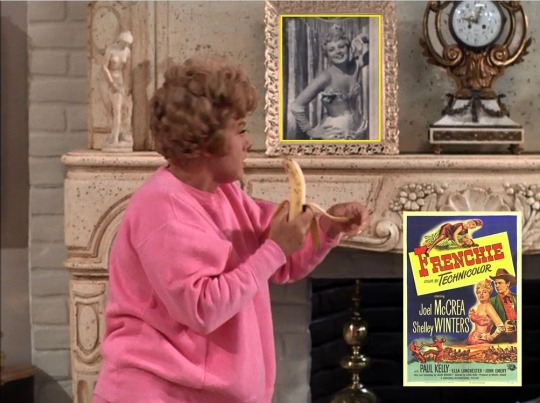
“Lucy and Shelley Winters” (1968)
Hired to watch over dieting movie star Shelley Summers. On the mantle of Summers' apartment is a photo of a svelte Shelley Winters from the 1950 film Frenchie. She glances guiltily at the photo when she is about to overeat.
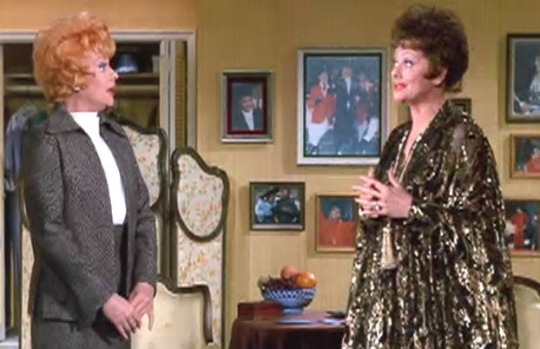
“Lucy Carter Meets Lucille Ball” (1974)
Although Lucille Ball's dressing room wall is lined with photographs of Mame and the soundtrack plays the title tune by Jerry Herman, the name of the movie is never specifically mentioned. The film was given its world premiere on March 7, 1974 three days after this episode first aired, and released nationally three weeks later. As Mame, Lucy failed to ‘charm the husk off of the corn.’
#Lucille Ball#Here's Lucy#Gale Gordon#TV#Movies#Shelley Winters#Vincent Price#Wally Cox#Bette Davis#Ruth Buzzi#Ginger Rogers#Van Johnson#Lucie Arnaz#Desi Arnaz Jr.#Carol Burnett#Don Knotts#Racquel Welch#Richard Burton#Elizabeth Taylor#Chuck Connors#Dan Dailey#Flip Wilson#Rudy Vallee
10 notes
·
View notes
Text
Airline Glamour Girls (1949). Instructional film from 1949. This short film follows a young woman who is training to be a airline stewardress at the McConnell Hostess School in Minneapolis, MN. Running Time: 9 Minutes and 18 Seconds. Instructions on how to be glamorous, how to walk in high heels, flight safely, unruly passengers etc.
RKO Screenliner Series #11. (Lastly since this is my private blog, no Periscope assholes are going to tell me to take this down. This isn't YouTube. Their are no copyright strikes for Tumblr. And in my opinion, this film should be in the public domain.
#Airline Glamour Girls (1949)#airlines#Stewardress#Flight Attendants#circa 1949#short documentary#how to be glamorous#how to walk in high heels 👠#flight ✈️ safety instructions#unruly passengers etc#RK0 Screenliner#11
7 notes
·
View notes
Text
About Orson Welles specifically: he is not even necessarily talking about poverty in the "unable to eat" way that some people in the notes have mentioned, which I want to bring up because he did grow up during the great depression. Welles's family was relatively affluent and when he was orphaned at 15, he had money to finish school and to travel a little in Europe, getting a job in a theater in Ireland and later in radio where he made so many radio plays in such a short about of time for about two years there he made about $2,000 a week. In 1937 money. This is before the War of the Worlds incident (likely hyped to wild levels afterwards because "some people who missed the beginning a bit startled by radio program" doesn't sell papers like "radio program creates mass hysteria" does) and eventually he was offered an extremely generous contract from the company RKO, especially considering he'd never made a movie before. He hosted two international radio shows and was asked to make a film about south america (Yes All Of It) as a goodwill ambassador, the same concept that gave us The Three Amigos from Disney
So where did all that money go?
Welles was fairly infamous for going over time and over budget. Citizen Kane was put in a vault for years after the Hearst newspapers didn't carry stories for it since Kane was partly inspired by Hearst's life (pov: guy who hated him), and Insinuating Things about his patriotism when he was not drafted for WWII. Magnificent Andersons got a scary preview audience review and got 50 minutes chopped off. And like 1/3rd the way through the goodwill project, he was fired from RKO after a leadership change that pretty heavily ruined his reputation.
Welles continued to film for half a year without compensation in South America.
He returned to radio to make money, and invested 40k of his own money to build a charity circus in Hollywood that allowed military members in for free while the general public had to pay, all proceeds going to the Military Assistance League, a charity for military personnel.
He hosted war loan drives to finance the Normandy invasion on request of FDR.
And he had to finance almost every film he made from then on. Because Hollywood had screwed him over so badly on his first three. Later on in life films would sometimes have to go on hiatus because he would stop to raise funds to pay everyone and buy the supplies. They worked on found sets and looked for sponsors who always fell through. He hired his friends over and over again for multiple movies, and people would return to work with him despite these problems and the reputation-- which of course became even more late, expensive films.
His poverty very literally stood in the way of his creativity. Not because he didn't have the money to eat. Every moment in between making things was spent trying to finance them.
His first fucking film was Citizen Kane.
And it was also one of the only ones financed by someone all the way through.
Imagine if the road had been cleared, instead
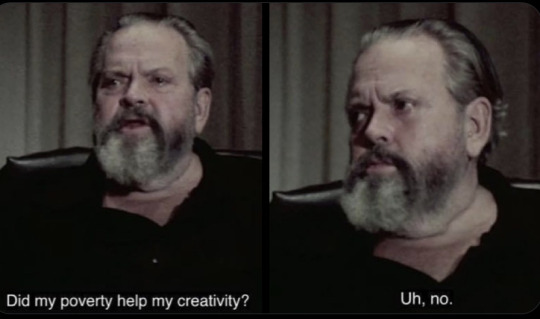
#it's late at night not sure what to do with this#sorry#orson welles#i think he's another guy who#the only thing worse than making a film is not being making a film
15K notes
·
View notes
Text
0 notes